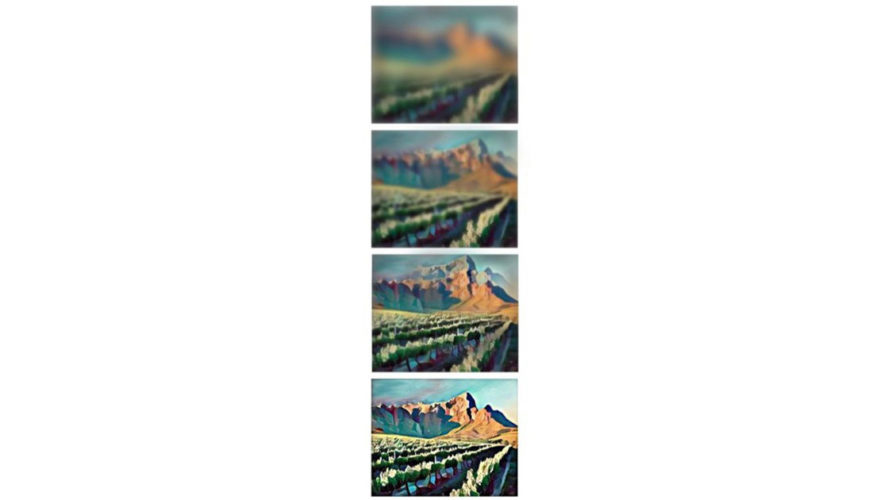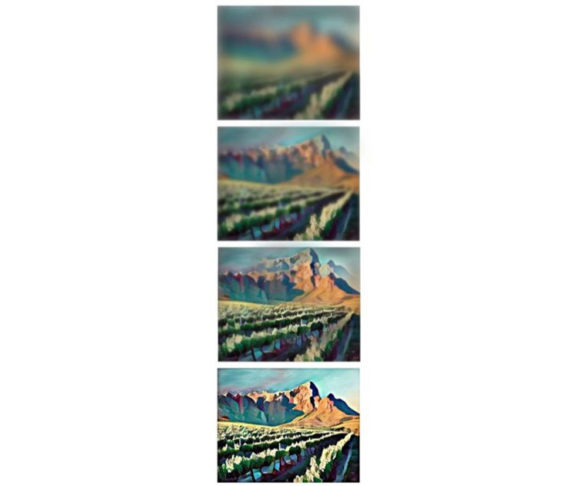When words fail to describe the experience of losing vision to eye disease, works of art can show how it looks to see the world, as colors dull and vision blurs.
In the late works of Claude Monet, you can see how cataracts affected his vision, resulting in landscapes suffused with a hazy, yellowish tint. Edgar Degas’ late paintings are marked by blurry undertones, likely the result of retinal disease. So, when Mark Rouse, a 65-year-old oil painter, began to lose vision to diabetic eye disease, he didn’t give up painting. Instead, he took inspiration from the Impressionist masters and created a series of paintings that depict what it looks like to lose your vision to diabetic retinopathy.
But Mark didn’t just illuminate the loss, he also showed what it’s like to regain vision. He created a series of four paintings, each depicting the same mountain range, but at different points in Mark’s recovery, beginning when he was legally blind through the restoration of his sight. It’s a powerful visual message to people with diabetes about the benefit of making lifestyle changes and the miracle of modern medicine.
Diabetes and vision loss
Like some 58% of people with diabetes, Mark didn’t get a yearly comprehensive eye exam. These vision screens are vital because they can catch diabetes-related eye diseases, some of which can steal vision before you experience any symptoms.
So, when Mark’s vision began to deteriorate, he assumed it was just part of aging and he made an appointment with his optometrist to get new eyeglasses. But the exam revealed that a stronger prescription wasn’t going to fix his vision. Instead, the optometrist promptly referred Mark to an ophthalmologist— a physician who specializes in medical and surgical eye care — who diagnosed him with diabetic retinopathy.
Diabetic retinopathy is the leading cause of blindness in working-age adults. It’s caused when high blood sugar damages blood vessels in the retina, light-sensitive cells in the back of the eye. Damaged blood vessels can swell and leak, causing blurry vision. If detected early, about 90% of vision loss from diabetes can be prevented. By the time Mark went to ophthalmologist Raj Maturi, M.D., he was already legally blind. Legally blind means that even with glasses or contacts, you can only read the first letter at the top of the vision chart, the big “E”. People who are totally blind are unable to sense light or see anything at all.
Dr. Maturi told Mark he couldn’t promise he would restore his eyesight, but he would make sure he didn’t lose any more of his vision.
“It was devastating,” Mark says. “You always think you have time to do things. At that point, I was out of time. I realized I may never paint again.”
What does it look like to go blind?
“I used to be a lazy painter,” Mark says. But after the diagnosis he began to pay more attention to the beauty around him. He was inspired; the natural world would be the new focus of his paintings. The new focus would also require a new technique to accommodate his vision loss.
To paint again, he used the same technique he used to see his computer screen for his day job — he connected his computer to his 55-inch television.
Using his screen as an enlarged digital canvas, Mark used both traditional painting techniques and digital editing tools to create art, a technique Mark calls “scan washes.” He would paint the background using regular watercolors, scan the start of the painting to his computer, and then complete the rest of the image digitally.
This is how he created the series of four paintings for an art show themed The Healing Power of Art.
“Each painting shows what my vision looked like every year over four years of treatment, starting from when my vision was at its worst,” says Mark. “It’s one thing to say things looked blurry and another to apply blurriness digitally until it looks just how I remember it. When one eye recovered faster than the other, for example, I had double vision. You can see that depicted at the top of the mountains in the painting.”
A remarkable recovery
Mark’s recovery was truly astounding. A typical patient who comes in with advanced vision loss from diabetes usually sees a 50% improvement in vision. About 15% of patients will see results like Mark’s, Dr. Maturi says.
Mark’s treatment included a series of eye injections and nine surgeries. His decision to become more health conscious was also vital to his recovery. Instead of allowing his blood sugar levels to fluctuate, he started checking his blood sugar consistently and adjusted his diet as needed.
“Regaining 20/20 vision is not common, but it can happen. Mark is a good patient who follows through on all instructions, and that really helped. Most importantly, he came in for follow-up appointments as necessary,” Dr. Maturi explains.
In addition to Mark’s diligence, Dr. Maturi credits Mark’s positive attitude as an important factor in the recovery process. “Mark required multiple treatments, but he never lost hope.”
A combination of hope, effort, and medicine produced a remarkable recovery. “My vision is now as good as it was in high school,” Mark says.
“I was absolutely blown away,” Dr. Maturi says of Mark’s artwork. “When you are working so hard to make a significant difference in someone’s life by saving their sight or giving them nearly perfect vision back, it makes me extremely grateful for the medicine we have today. Especially when that person is an artist. In Mark’s case, it gave him his vocation back.”
Mark continues to create digital paintings using his scan wash technique. You can find more of his work at www.markrouse.com.



